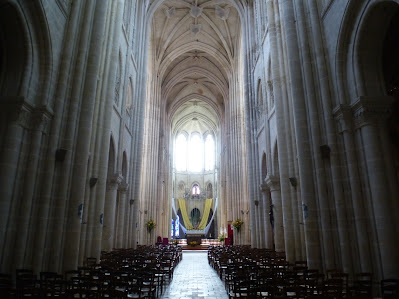The
aire in Beauvais was OK and free and just across from a shopping center with a super-duper-marche and cafe and many other shoppes. I was in heaven. Also a cheap
lavarie where I did the wash. So we spent an extra day, a productive administrative day, despite lack of wifi. Vicki did research for further journeys. Next morning we drove on, in threatening clouds and cold (it's late May) to Senlis and the first of the day's two transitional Gothic cathedrals. Senlis, north of Paris, was an important center in the earlier Middle Ages. Paris' bishop reported to Senlis' bishop for some time, and the bishops of Senlis crowned the kings of France. Or maybe that was Sens.* Anyway...
 |
Senlis cathedral, yet another Notre Dame, begun in the mid-
12th and finished before the 13th; then, as we'll see,
remodeled extensively (fires, etc.) in later Gothic; from the
south; flying buttresses all around the apse |
 |
| The big south tower |
 |
Interior, nave, looking to the east and the burst of brilliance
there...[interlude for theological reflection]...; I like to refer
to this as the knave view |
 |
| South rose window |
 |
Crossing; under nets; interestingly, the older ribbed
vaulting is fine, but the later Gothic add-on ornaments,
hanging down off the ceilings, are crumbling; thus the
nets |
 |
Elevation: big aisles, big galleries, no triforia,
not-so-big clerestory windows; an earlier
stage in transition |
.jpg) |
And, as in the previous shot, the really cool thing to note
at Senlis is the use of alternating columns (classical
columns, with Corinthian capitals) with big Medieval piers;
sort of a Romanesque/Gothic/Romanesque/Gothic
arrangement; originally related to the vaulting, requiring
a heavy support/medium support alternation, this pattern
quickly died out, with uniform large piers replacing it |
 |
Ceiling of the large south-side chapel of St. Anonymous;
note the huge later Gothic down-hanging ornamentation
thingie (there's a name for this, I am sure, and I must add
it to the inventory already cluttering my mind); anyhow,
this one is relatively low-down and evidently not
deteriorating like the one's high up that require nets |
 |
There is a fair amount of nice glass, later Medieval-looking,
higher up |
 |
| E.g., Susanna and the Dirty Old Men |
 |
Looking into a crypt, dated 1000AD, burial site for SS
Gervais and Prothais |
 |
| Starboard portal |
 |
West facade; the north tower was eaten by
termites, according to the Condemnations
of 1277, which was taken as a sign that...
wait...no... |
 |
West typanum and earlier Gothic sculpture;
another life of Mary |
 |
By the mid 13th century, Medieval sculpture was beginning
to show motion and emotion; note particularly the jamb-
statue on the right, a St. John I think, who seems to be
saying "Hurry up! I have to go...!" |
 |
Adjacent to the cathedral is a good bit of earlier Medieval
and even Gallo-Roman ruins; here, bits of a royal chapel |
 |
Then, as we were walking back to the
camper, the storm finally hit, rain and then
wintry mix; we ducked under an old wall
and noticed the sign, which reads "Rempart
Gallo-Romain IIIe Siecle" |
 |
I was trying to shoot the hail bouncing off
the roof of the building across the street...
Goth'Ink is a tattoo shop |
 |
| Pea-size hail accumulating on our wind-shield |
*Further research has shown that it was indeed Sens that was superior to Paris, bishoprically.... We'll get there next fall.























.jpg)


































